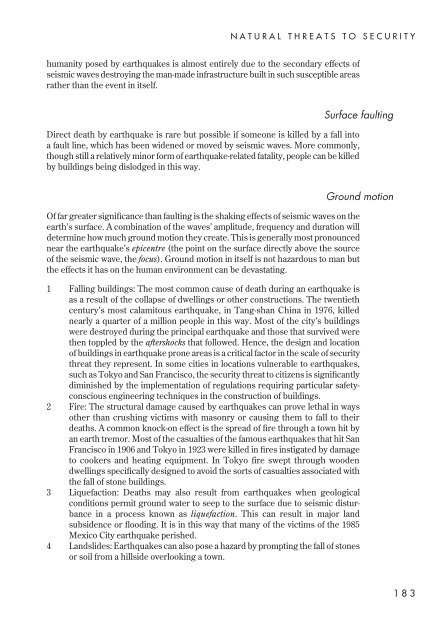Understanding global security - Peter Hough
Understanding global security - Peter Hough
Understanding global security - Peter Hough
You also want an ePaper? Increase the reach of your titles
YUMPU automatically turns print PDFs into web optimized ePapers that Google loves.
NATURAL THREATS TO SECURITY<br />
humanity posed by earthquakes is almost entirely due to the secondary effects of<br />
seismic waves destroying the man-made infrastructure built in such susceptible areas<br />
rather than the event in itself.<br />
Surface faulting<br />
Direct death by earthquake is rare but possible if someone is killed by a fall into<br />
a fault line, which has been widened or moved by seismic waves. More commonly,<br />
though still a relatively minor form of earthquake-related fatality, people can be killed<br />
by buildings being dislodged in this way.<br />
Ground motion<br />
Of far greater significance than faulting is the shaking effects of seismic waves on the<br />
earth’s surface. A combination of the waves’ amplitude, frequency and duration will<br />
determine how much ground motion they create. This is generally most pronounced<br />
near the earthquake’s epicentre (the point on the surface directly above the source<br />
of the seismic wave, the focus). Ground motion in itself is not hazardous to man but<br />
the effects it has on the human environment can be devastating.<br />
1 Falling buildings: The most common cause of death during an earthquake is<br />
as a result of the collapse of dwellings or other constructions. The twentieth<br />
century’s most calamitous earthquake, in Tang-shan China in 1976, killed<br />
nearly a quarter of a million people in this way. Most of the city’s buildings<br />
were destroyed during the principal earthquake and those that survived were<br />
then toppled by the aftershocks that followed. Hence, the design and location<br />
of buildings in earthquake prone areas is a critical factor in the scale of <strong>security</strong><br />
threat they represent. In some cities in locations vulnerable to earthquakes,<br />
such as Tokyo and San Francisco, the <strong>security</strong> threat to citizens is significantly<br />
diminished by the implementation of regulations requiring particular safetyconscious<br />
engineering techniques in the construction of buildings.<br />
2 Fire: The structural damage caused by earthquakes can prove lethal in ways<br />
other than crushing victims with masonry or causing them to fall to their<br />
deaths. A common knock-on effect is the spread of fire through a town hit by<br />
an earth tremor. Most of the casualties of the famous earthquakes that hit San<br />
Francisco in 1906 and Tokyo in 1923 were killed in fires instigated by damage<br />
to cookers and heating equipment. In Tokyo fire swept through wooden<br />
dwellings specifically designed to avoid the sorts of casualties associated with<br />
the fall of stone buildings.<br />
3 Liquefaction: Deaths may also result from earthquakes when geological<br />
conditions permit ground water to seep to the surface due to seismic disturbance<br />
in a process known as liquefaction. This can result in major land<br />
subsidence or flooding. It is in this way that many of the victims of the 1985<br />
Mexico City earthquake perished.<br />
4 Landslides: Earthquakes can also pose a hazard by prompting the fall of stones<br />
or soil from a hillside overlooking a town.<br />
183
















